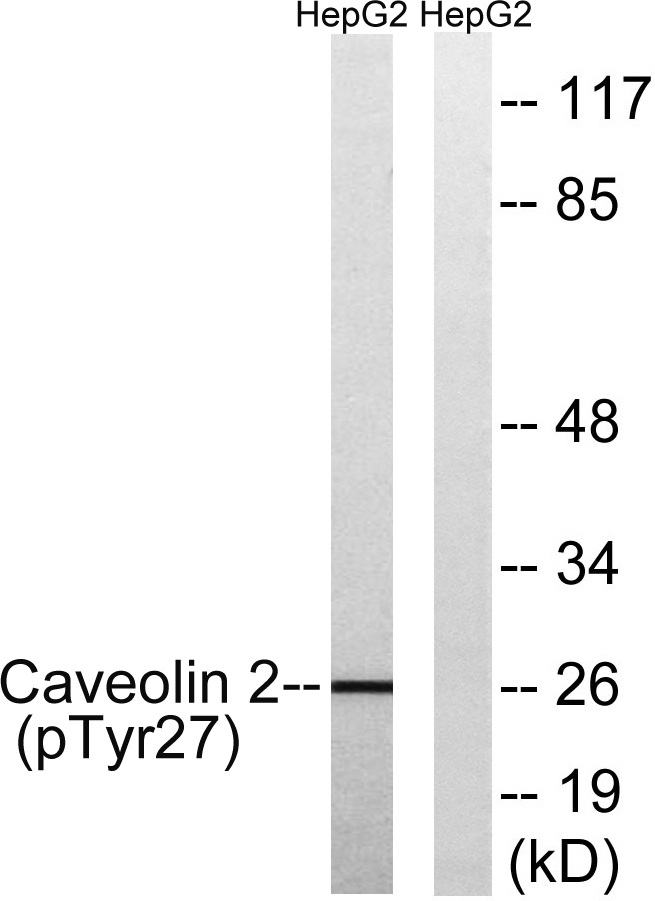Caveolin-2 (phospho Tyr27) Polyclonal Antibody
- Catalog No.:YP0454
- Applications:WB;ELISA
- Reactivity:Human;Rat;Mouse;
- Target:
- Caveolin-2
- Fields:
- >>Endocytosis;>>Focal adhesion;>>Prion disease;>>Bacterial invasion of epithelial cells;>>Proteoglycans in cancer;>>Fluid shear stress and atherosclerosis
- Gene Name:
- CAV2
- Protein Name:
- Caveolin-2
- Human Gene Id:
- 858
- Human Swiss Prot No:
- P51636
- Mouse Swiss Prot No:
- Q9WVC3
- Immunogen:
- The antiserum was produced against synthesized peptide derived from human Caveolin 2 around the phosphorylation site of Tyr27. AA range:12-61
- Specificity:
- Phospho-Caveolin-2 (Y27) Polyclonal Antibody detects endogenous levels of Caveolin-2 protein only when phosphorylated at Y27.
- Formulation:
- Liquid in PBS containing 50% glycerol, 0.5% BSA and 0.02% sodium azide.
- Source:
- Polyclonal, Rabbit,IgG
- Dilution:
- WB 1:500 - 1:2000. ELISA: 1:10000. Not yet tested in other applications.
- Purification:
- The antibody was affinity-purified from rabbit antiserum by affinity-chromatography using epitope-specific immunogen.
- Concentration:
- 1 mg/ml
- Storage Stability:
- -15°C to -25°C/1 year(Do not lower than -25°C)
- Other Name:
- CAV2;Caveolin-2
- Observed Band(KD):
- 26kD
- Background:
- The protein encoded by this gene is a major component of the inner surface of caveolae, small invaginations of the plasma membrane, and is involved in essential cellular functions, including signal transduction, lipid metabolism, cellular growth control and apoptosis. This protein may function as a tumor suppressor. This gene and related family member (CAV1) are located next to each other on chromosome 7, and express colocalizing proteins that form a stable hetero-oligomeric complex. Alternatively spliced transcript variants encoding different isoforms have been identified for this gene. Additional isoforms resulting from the use of alternate in-frame translation initiation codons have also been described, and shown to have preferential localization in the cell (PMID:11238462). [provided by RefSeq, May 2011],
- Function:
- function:May act as a scaffolding protein within caveolar membranes. Interacts directly with G-protein alpha subunits and can functionally regulate their activity.,function:May act as a scaffolding protein within caveolar membranes. Interacts directly with G-protein alpha subunits and can functionally regulate their activity. Caveolin-2 may function as an accessory protein in conjunction with caveolin-1.,online information:Caveolin entry,similarity:Belongs to the caveolin family.,subcellular location:Potential hairpin-like structure in the membrane. Membrane protein of caveolae.,subunit:Homodimer. Caveolin-1 and -2 colocalize and form a stable hetero-oligomeric complex.,tissue specificity:Expressed in endothelial cells, smooth muscle cells, skeletal myoblasts and fibroblasts.,
- Subcellular Location:
- Nucleus. Cytoplasm. Golgi apparatus membrane; Peripheral membrane protein. Cell membrane; Peripheral membrane protein. Membrane, caveola; Peripheral membrane protein. Potential hairpin-like structure in the membrane. Membrane protein of caveolae. Tyr-19-phosphorylated form is enriched at sites of cell-cell contact and is translocated to the nucleus in complex with MAPK1 in response to insulin (By similarity). Tyr-27-phosphorylated form is located both in the cytoplasm and plasma membrane. CAV1-mediated Ser-23-phosphorylated form locates to the plasma membrane. Ser-36-phosphorylated form resides in intracellular compartments. .
- Expression:
- Expressed in endothelial cells, smooth muscle cells, skeletal myoblasts and fibroblasts.
- June 19-2018
- WESTERN IMMUNOBLOTTING PROTOCOL
- June 19-2018
- IMMUNOHISTOCHEMISTRY-PARAFFIN PROTOCOL
- June 19-2018
- IMMUNOFLUORESCENCE PROTOCOL
- September 08-2020
- FLOW-CYTOMEYRT-PROTOCOL
- May 20-2022
- Cell-Based ELISA│解您多样本WB检测之困扰
- July 13-2018
- CELL-BASED-ELISA-PROTOCOL-FOR-ACETYL-PROTEIN
- July 13-2018
- CELL-BASED-ELISA-PROTOCOL-FOR-PHOSPHO-PROTEIN
- July 13-2018
- Antibody-FAQs
- Products Images

- Western blot analysis of lysates from HepG2 cells treated with EGF 200ng/ml 5' , using Caveolin 2 (Phospho-Tyr27) Antibody. The lane on the right is blocked with the phospho peptide.



